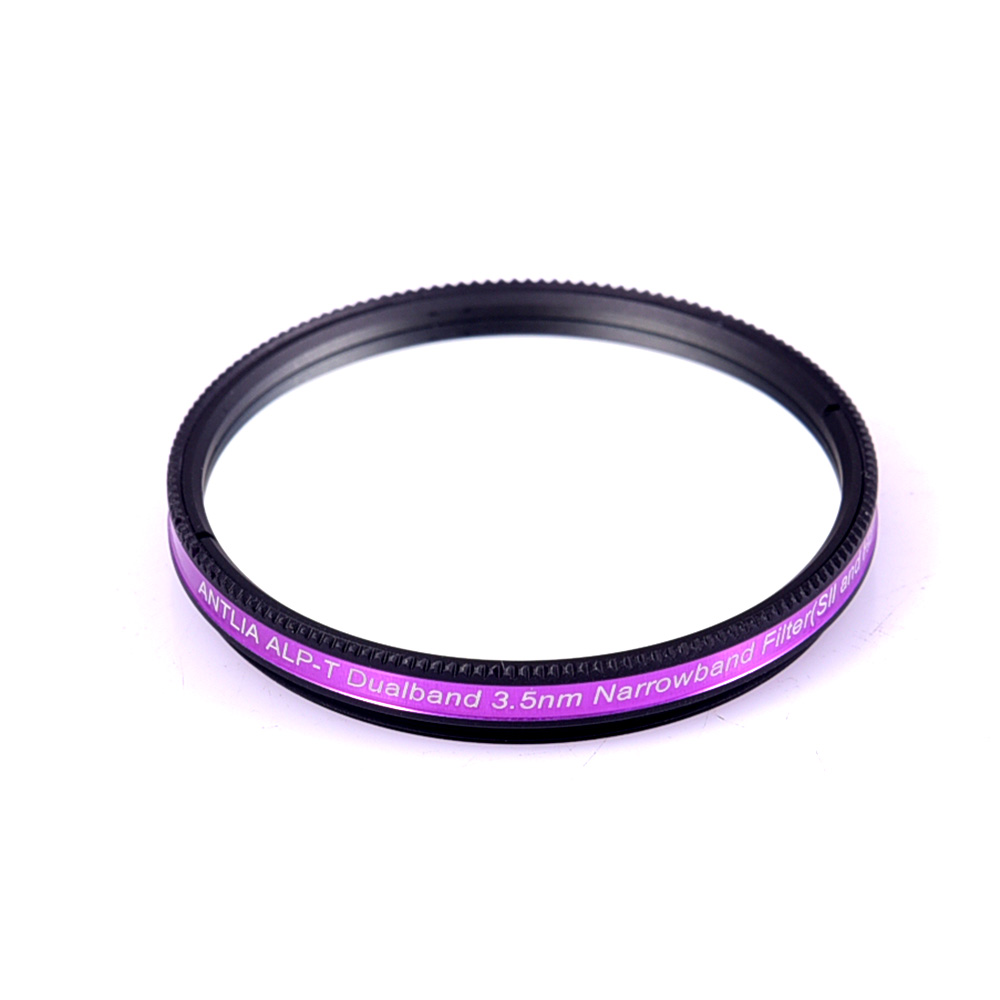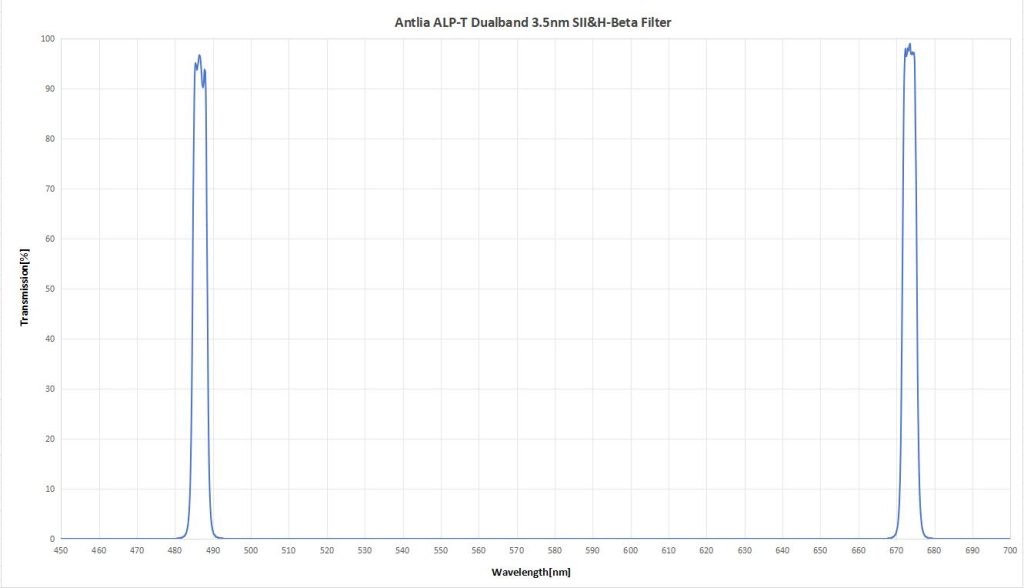The ALP-T Dual Band 3.5nm SII & H-beta filter is a precision dual narrowband filter that transmits the deep red Sulphur-II (672.4nm) and blue Hydrogen-beta (486.1nm) emission lines. Antlia engineered this filter specifically for colour cameras, helping astrophotographers capture deep-sky images with significantly enhanced signal-to-noise ratio (SNR). With a finely tuned 3.5nm FWHM and optical density (OD) of 4.5, the filter effectively blocks unwanted light from sources such as light pollution, moonlight, and airglow. This results in higher contrast by isolating the SII and H-beta signals with exceptional clarity.
This filter serves as a valuable companion to the widely used Antlia ALP-T Dual Band Ha & OIII filter. When used together, they allow OSC users to create narrowband and false-colour images by capturing all four key emission lines—Ha, OIII, SII, and H-beta. These channels can be separated and recombined during post-processing to form a variety of colour palettes, such as H-O-Hb, S-H-O, H-S-OHb, and H-O-O. These combinations enhance both visual appeal and structural detail, while also offering the option to boost luminance contrast in traditional RGB-balanced images.
Antlia applies advanced multi-coatings to all ALP-T dual-band filters to ensure precise isolation of critical wavelengths—including Ha, OIII, SII, and H-beta—while suppressing unwanted signals with OD4.5 optical blocking. These coatings minimise interference from artificial light sources and natural skyglow, helping you achieve high contrast and cleaner data whether imaging in urban or dark-sky locations.
Both the Ha & OIII and SII & H-beta filters in the ALP-T range deliver outstanding performance with OSC cameras. Together, they offer a powerful solution for capturing detailed, high-contrast celestial images—making them ideal tools for astrophotographers who want to unlock the full potential of narrowband imaging.
Why did Antlia design an SII & H-beta filter instead of an OIII & SII version?
Antlia developed the SII & H-beta filter to capture two often underutilised but important emission lines. While Sulphur-II (SII) emits in the deep red part of the spectrum beyond H-alpha, the Hydrogen-beta (H-beta) line—despite being the second most common hydrogen emission after H-alpha—is frequently overlooked in astrophotography. Many nebulae contain structures that emit strongly in the blue H-beta region, which H-alpha, OIII, and even SII filters can’t detect. By targeting both SII and H-beta, this filter reveals richer detail and achieves a stronger signal-to-noise ratio in areas where H-beta contributes significantly to the nebular emission.
Capturing more OIII might increase signal strength, but it doesn’t always add new information. H-beta, however, can expose structural features not visible with OIII. That’s why Antlia chose to include it. In nebulae with blue spectral components, H-beta adds a level of detail and contrast enhancement not possible with other filters.
It’s also important to consider the performance of OIII with colour cameras. Most OSC sensors use an RGGB Bayer matrix, which includes twice as many green pixels as red or blue. This makes OSC cameras naturally efficient at capturing OIII. For stronger OIII results, you can use the Antlia ALP-T Ha & OIII filter and isolate the green and blue channels during post-processing to synthesise a dedicated OIII layer for your image stack.
If your goal is simply to add SII to Ha & OIII data, then a dedicated narrowband SII filter might provide the cleanest result. However, Antlia’s SII & H-beta filter offers something more—it includes the H-beta line, which boosts contrast and improves feature separation in nebulae where H-beta is prominent. This makes the SII & H-beta filter a more versatile option for OSC users looking to extract deeper detail.
Antlia ALP-T Dual Band Ha & OIII Filter:
This dual band filter features a very narrow passband for H-alpha and OIII, delivering high signal-to-noise ratio and impressive contrast enhancement for colour cameras.
Antlia ALP-T Dual Band SII & H-beta Filter:
This filter targets the H-beta and SII lines with a narrow 3.5nm bandpass. It excels at increasing contrast in nebulae that emit strongly in these wavelengths and improves detail separation in H-beta regions, making it a powerful addition to any OSC imaging setup.
Application and Performance:
-
Passes Sulphur-II (SII) at 672.4nm and Hydrogen-beta (H-beta) at 486.1nm
-
Captures deep red and blue emission wavebands simultaneously
-
Features an ultra-narrow 3.5nm FWHM for longer exposures and detailed nebula capture
-
Designed primarily for colour cameras to produce cleaner data
-
Also works as a luminance filter with monochrome cameras to save imaging time
-
Pairs well with the ALP-T Dual Band Ha & OIII filter for four-channel imaging (Ha, OIII, SII, H-beta)
-
Provides better signal-to-noise ratio and improved channel separation when used together
-
Suppresses unwanted wavelengths with OD4.5 optical density to boost SNR
-
Blocks near-infrared (NIR) wavelengths up to 1100nm
-
Maintains spectral accuracy with a flat-top, moderate bandpass that limits spectrum shift
-
Performs best with optics slower than f/4; for faster systems, use the pre-shifted highspeed version
-
Uses Ion Gun Assisted Deposition to apply multi-layer coatings on a double-sided polished substrate
-
Includes anti-reflective halo suppression coating to minimise halos and internal reflections
-
Effectively blocks artificial lighting from Bortle 1 to Bortle 8 skies
-
Features blackened edges (on unmounted versions) to reduce internal reflections
-
Built with Antlia’s proven coating technology for long-term durability
-
Performs exceptionally well with both colour and monochrome cameras, helping reduce imaging time
Spectrum Curve:
Filter Ring:
2” (M48*0.75)
Ultra-thin filter cell to minimize vignetting by maximize possible clear aperture
Black Anodized Finish
Laser Engraving No Fading
Not Recommended:
Solar imaging
Night visual observation



Reviews
There are no reviews yet.